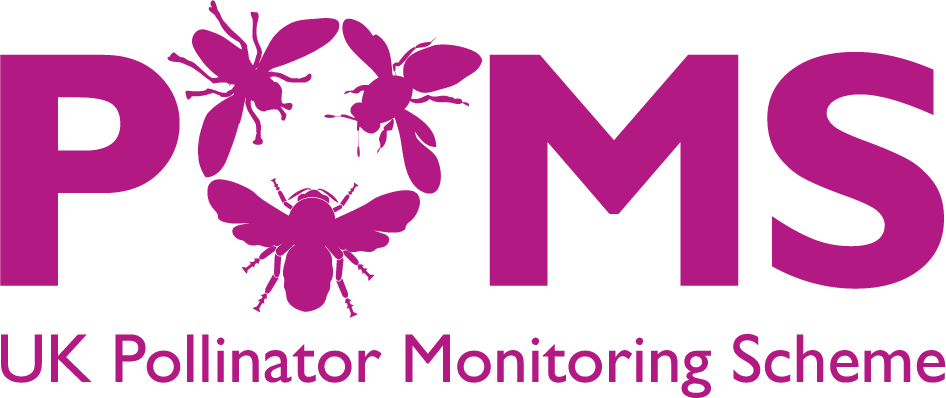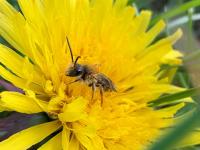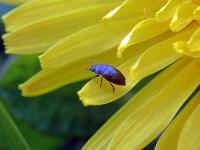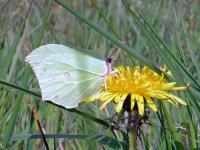Delightful dandelions
Dandelions seem to arouse strong feelings, both for and against, but for pollinating insects they are a delicious source of nectar and pollen! In this article Martin Harvey explores some of the ways in which insects and dandelions interact, and what you're likely to find during a dandelion FIT Count.
A solitary bee (male Gwynne's Mining Bee, Andrena bicolor) taking a deep dive into a dandelion - Martin Harvey |
FIT Counts on dandelions
Dandelions are one of the target flowers for carrying out the PoMS FIT Count survey, and there have been nearly 500 counts submitted for dandelions so far, with almost 3,000 individual insects counted. This works out at an average of 6 insects seen on dandelions per ten-minute FIT Count. However, the average is skewed by the occasional high count, and a FIT Count on dandelion is more likely to end up with a total of 2 to 4 insects.
FIT Counts on dandelions have also produced a number of zero counts, where no insects land on the flowers during the ten minutes, especially during April. People are sometimes disappointed if they see no insects during their FIT Count, and we are sometimes asked if zero counts should be reported. And the answer to that is: yes please! Zero counts are still important data for PoMS, and help us monitor just how many insects are visiting flowers at different locations and on different dates.
Main insect groups seen
Solitary bee (Andrena sp.) on dandelion flower - Robin Hutchinson |
A 'small insect' (pollen beetle, Meligethes aeneus) on dandelion - Martin Harvey |
The highest number of insects counted on a dandelion FIT Count is 106, of which 100 were “small insects”. Dandelions can attract very large numbers of tiny pollen beetles, for instance, and these are likely to be responsible for the highest numbers sent in. A study in North America counted numbers of insects visiting dandelion flowers, and in this experiment the most frequent visitors were honeybees, followed by beetles and “muscoid flies”, which are flies from families including Muscidae and Anthomyiidae (Lázaro, A., and Totland, Ø. 2010, Population dependence in the interactions with neighbors for pollination: A field experiment with Taraxacum officinale. American Journal of Botany, 97: 760-769.)
From the PoMS FIT Counts the most frequent visitors are small insects (which will include many beetles), and other flies (which will include many muscoid flies), so there is some similarity in the results from different continents. The FIT Counts do not generally record high numbers of honeybees, but this can be strongly influenced by the proximity of bee hives. The FIT Count app is being used in an increasing number of countries round the world, many of which are retaining dandelions as a target flower, and it will be interesting to see if the same pattern of insect visits holds true more widely. For PoMS in the UK you can see what insect groups are being counted on dandelions uaing our interactive flower and insect charts.
Insects interacting with dandelions
Brimstone butterfly feeding from dandelion flower - Martin Harvey |
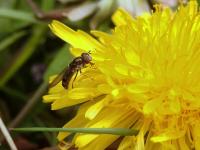
Hoverfly (Platycheirus albimanus) on dandelion flower - Martin Harvey |
A database of plant-pollinator interactions lists insects that have been recorded visiting dandelion flowers, producing a total of 90 different species of bee, 62 species of hoverfly and 25 species of butterfly (Redhead, J.W., et al. 2018. Plant-pollinator interactions database for construction of potential networks. NERC Environmental Information Data Centre.)
A further 55 species of insects that feed on dandelion leaves and stems are listed in the Database of Insects and their Food Plants. These include 31 species of moth, seven flies and six true bugs (Biological Records Centre. DBIF plant name search. Accessed 14 April 2022.) It’s clear that dandelions play an important role in interactions with a wide range of insects.
Delve into dandelions
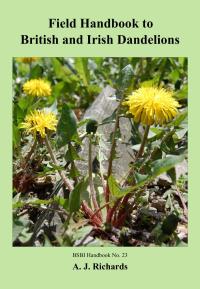
The BSBI handbook for dandelions |
The English name “dandelion” is derived from the Old French “dent de lion” or “tooth of the lion”. This refers to the toothed shape of the dandelion’s leaves. But in fact there is not just one dandelion species, there are around 250 in the UK! Dandelions have a complex range of reproductive behaviours, with a mix of sexual and asexual reproduction, and this has resulted in many different ‘microspecies’ of dandelion with genetic and physical differences.
For PoMS we don’t need to try to work out exactly which species we have, and it is fine just to record your counts as being on dandelions in general. However, if you’d like to know more about the different species there are some brilliant resources on the Dandelions page from the Botanical Society of Britain and Ireland, with video guides, info on training courses and details of the recently published Handbook for dandelion identification.
Get counting!
Next time you have time to spare on a warm sunny day why not find a patch of dandelions, and spend ten minutes watching what insect visitors arrive. Relaxing, enjoyable, and (as long as you send in the results) a valuable contribution to pollinator monitoring!
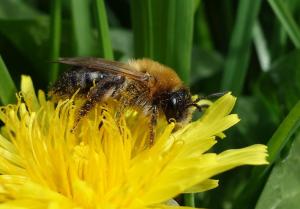
Solitary bee (female Grey-patched Mining Bee, Andrena nitida) coated in dandelion pollen - Nadine Mitschunas |
